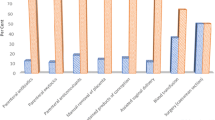Abstract
To assess the availability of, and challenges to the provision of emergency obstetric care in order to raise awareness and assist policy-makers and development partners in making appropriate decisions to help pregnant women in Iraq. Descriptive and exploratory study based on self-administered questionnaires, an in-depth interview and a Focus Group Discussion. The setting was 19 major hospitals in 8 out of the 18 Governorates and the participants were 31 Iraqi doctors and 1 midwife. The outcome measures were availability of emergency obstetric care (EOC) in hospitals and challenges to the provision of EOC. Only 26.3% (5/19) of hospitals had been able to provide all the 8 signal functions of comprehensive emergency obstetric care in the previous 3 months. All the 19 hospitals provided parenteral antibiotics and uterine evacuation, 94.7% (18/19) were able to provide parenteral oxytocics and perform manual removal of retained placenta, magnesium sulphate for eclampsia was available in 47.4% (9/19) of hospitals, 42.1% (8/19) provided assisted vaginal delivery, 26.5% (5/19) provided blood transfusion and 89.5% (17/19) offered Caesarean section. The identified challenges for health care providers include difficulties travelling to work due to frequent checkpoints and insecurity, high level of insecurity for patients referred or admitted to hospitals, inadequate staffing due mainly to external migration and premature deaths as a result of the war, lack of drugs, supplies and equipment (including blood for transfusion), and falling standards of training and regulation. Most women and their families do not currently have access to comprehensive emergency obstetric care. Health care providers recommend reconstruction and strengthening of all components of the Iraqi health system which may only be achieved if security returns to the country.

Similar content being viewed by others
References
UNICEF. (2009). Iraqi health update: Conflict fuels Iraqi health crisis. http://iraq.undg.org/index.cfm?Module=Static&page=w&s=backgroundlogistic. Accessed 03 June 2009.
Medact. (2008). Rehabilitation under fire: Health care in Iraq 2003–7. London: Medact.
UNDG, World Bank. (2009). Health and health care system in Iraq: An overview and options for the future Iraq health system. UNDG/World Bank Joint Need Assessment for Iraq Reconstruction. http://iraq.undg.org/index.cfm?Module=Static&page=w&s=backgroundlogistic. Accessed 03 June 2009.
Alwan, A. (2004). The current situation. Our vision for the future and areas of work (2nd ed.). Iraq Ministry of Health. http://www.who.int/hac/crises/irq/sitreps/2004/Iraq_Health_in_Iraq_Dec2004.pdf. Accessed 03 June 2009.
WHO, Iraq Ministry of Health. (2009). Vision for the Iraqi health system. Unpublished draft document. April 2004 [Online], http://www.emro.who.int/Iraq/moh_vision.htm. Accessed 26 May.
WHO. (2007). Maternal mortality in 2005: Estimates developed by WHO, UNICEF, UNFPA and the World Bank. Geneva: WHO.
Al-Araji, A. (2001). Iraqi doctors appeal for help from doctors in other countries. BMJ, 323, 53.
World Health Organization, UNFPA, UNICEF and AMDD. (2009). Monitoring emergency obstetric care. A handbook. Geneva: WHO.
Chynoweth, S. K. (2008). The need for priority reproductive health services for displaced Iraq women and girls. Reproductive Health Matters, 16(31), 93–102.
McKenna, M. (2003). Preparing for war in Iraq: Making reproductive health care a priority. Global Health Link, 121, 20–30.
Salvage, J. (2007). ‘Collateral damage’: The impact of war on the health of women and children in Iraq. Midwifery, 23(1), 8–12.
Burnham, G., Lafta, R., Doucy, S., Roberts, L., et al. (2006). Mortality after the 2003 invasion of Iraq: A cross-sectional cluster sample survey. Lancet, 368, 1421–1428.
Roberts, L., Lafta, R., Garfield, R., Khudhairi, J., Burnham, G., et al. (2004). Mortality before and after the 2003 invasion of Iraq: Cluster sample survey. Lancet, 364, 1857–1864.
Acknowledgments
We acknowledge Human Relief Foundation United Kingdom for providing the funding for training the health care personnel from Iraq in Life Saving Skills and Emergency Obstetric and Newborn Care.
Competing Interest Statement
All authors declare that we have no competing interest and therefore have nothing to declare.
Author information
Authors and Affiliations
Corresponding author
Additional information
Sophie Bishop, Eugene Kongnyuy, Kate Grady and Nynke Van den Broek are equally contributed to this work. All authors contributed to the design of the study. CAA and SB collected and analysed the data, EK, KG and NVdB contributed to drafting the article.
Rights and permissions
About this article
Cite this article
Ameh, C.A., Bishop, S., Kongnyuy, E. et al. Challenges to the Provision of Emergency Obstetric Care in Iraq. Matern Child Health J 15, 4–11 (2011). https://doi.org/10.1007/s10995-009-0545-3
Published:
Issue Date:
DOI: https://doi.org/10.1007/s10995-009-0545-3




